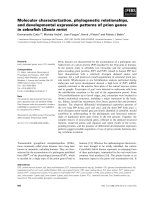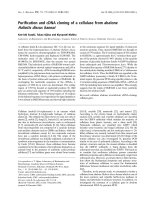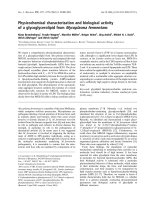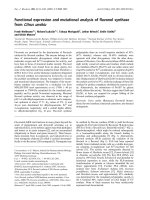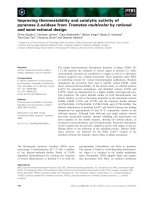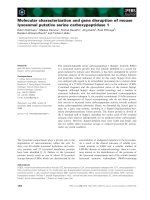Báo cáo khoa học: " Molecular characterization and phylogenetic analysis of the complete genome of a porcine sapovirus from Chinese swine" pdf
Bạn đang xem bản rút gọn của tài liệu. Xem và tải ngay bản đầy đủ của tài liệu tại đây (573.75 KB, 10 trang )
BioMed Central
Page 1 of 10
(page number not for citation purposes)
Virology Journal
Open Access
Research
Molecular characterization and phylogenetic analysis of the
complete genome of a porcine sapovirus from Chinese swine
Shixing Yang
†1
, Wen Zhang
†2
, Quan Shen
1
, Fen Huang
1
, Yan Wang
1
,
Jianguo Zhu
1
, Li Cui
1
, Zhibiao Yang
1
and Xiuguo Hua*
1
Address:
1
School of Agriculture and Biology, Shanghai Jiao Tong University, 800 Dong Chuan Road, Shanghai 200240, PR China and
2
School of
Medical Science and Laboratory Medicine, Jiangsu University, 301 Xuefu Road, Zhenjiang, Jiangsu 212013, PR China
Email: Shixing Yang - ; Wen Zhang - ; Quan Shen - ;
Fen Huang - ; Yan Wang - ; Jianguo Zhu - ; Li Cui - ;
Zhibiao Yang - ; Xiuguo Hua* -
* Corresponding author †Equal contributors
Abstract
Background: Porcine sapovirus was first identified in the United States in 1980, hitherto, several
Asian countries have detected this virus. In 2008, the first outbreak of gastroenteritis in piglets
caused by porcine sapovirus in China was reported. The complete genome of the identified SaV
strain Ch-sw-sav1 was sequenced and analyzed to provide gene profile for this outbreak.
Methods: The whole genome of Ch-sw-sav1 was amplified by RT-PCR and was sequenced.
Sequence alignment of the complete genome or RNA dependent RNA polymerase (RdRp) gene
was done. 3' end of ORF2 with 21-nt nucleotide insertion was further analyzed using software.
Results: Sequence analysis indicated that the genome of Ch-sw-sav1 was 7541 nucleotide long
with two ORFs, excluding the 17 nucleotides ploy (A) at the 3' end. Phylogenetic analysis based on
part of RdRp gene of this strain showed that it was classified into subgroup GIII. Sequence alignment
indicated that there was an inserted 21-nt long nucleotide sequence at the 3' end of ORF2. The
insertion showed high antigenicity index comparing to other regions in ORF2.
Conclusion: Ch-sw-sav1 shared similar genetic profile with an American PEC strain except the
21-nt nucleotide at the 3' end of ORF2. The insert sequence shared high identity with part gene of
Sus scrofa clone RP44-484M10.
Background
Caliciviridae is a family of positive sense single-stranded
RNA viruses comprised of both human and animal path-
ogens [1]. Caliciviridae family contains four genera, Lago-
virus, Vesivirus, Norovirus and Sapovirus [2]. Various
caliciviruses possess common features. For example, they
are small, non-enveloped virus, 27-38 nm in diameter.
They possess a single-stranded, 7.3-8.3 kb plus-sense RNA
genome, a single 56-71 kD capsid protein [3], and a poly-
protein containing confering motifs of a putative 2C heli-
case, 3C-like protease, and 3D RdRp. SaV are recognized
as emerging enteric pathogens in humans, swine and
mink [4]. SaV infection may cause diarrhea especially in
the younger [5]. It is currently divided into eight distinct
genetic groups (GI-GVIII) based on the RdRp gene.
Among these genetic groups, GIII can't infect humans but
Published: 6 December 2009
Virology Journal 2009, 6:216 doi:10.1186/1743-422X-6-216
Received: 18 August 2009
Accepted: 6 December 2009
This article is available from: />© 2009 Yang et al; licensee BioMed Central Ltd.
This is an Open Access article distributed under the terms of the Creative Commons Attribution License ( />),
which permits unrestricted use, distribution, and reproduction in any medium, provided the original work is properly cited.
Virology Journal 2009, 6:216 />Page 2 of 10
(page number not for citation purposes)
can be cultured in vitro in the presence of bile acid [6]. The
genome of SaV consists of 7.1-7.5 kb nucleotide and
encodes two or three open reading frames (ORFs). ORF1
encodes one polyprotein that contains coding sequences
for the nonstructural proteins and the major capsid pro-
tein (VP1), ORF2 encodes the minor structural protein
(VP2), while ORF3 is only present in strains from geno-
types GI, GIV and GV, and encodes a small basic protein
[7]. SaV is considered as a significant global enteropatho-
gen of acute gastroenteritis [8]. Recently, it was shown that
the host tropism of some calicivirus is less specific. Some
calicivirus may have zoonotic potential, and animals such
as domestic pig may be a reservoir for caliciviruses [9-11].
Porcine sapovirus was first identified in the United States
by electron microscopy in 1980 [12] and genetically char-
acterized as a sapovirus in 1999 [13]. Recently, SaV infec-
tions have been identified in Japan, South Korea,
Venezuela, Hungary and Belgium [14-18]. In the United
States, porcine sapovirus was also detected from Oyster
[19]. Although porcine SaV was mainly detected in pigs,
some studies indicated that some porcine SaV might be
potential pathogencity transmitting to humans. For exam-
ple, the porcine SaV strain (Sapovirus pig/43/06-18p3/
06/ITA) isolated from Italy was most closely related to
human SaV through the alignment of RdRp sequences,
suggesting the possibility of a pig reservoir for human
strains or vice versa [20]. We previously reported an out-
break of gastroenteritis in piglets in China caused by the
first Chinese porcine SaV strain [21]. In this study, gene
profile of this strain was investigated, the entire viral
genome and 3' end of Ch-sw-sav1 were cloned and
sequenced.
Methods
Samples
Porcine SaV positive fecal samples were collected from
commercial pig farms in Shanghai as introduced in our
previous study. Samples were converted to 20% (wt/vol)
suspensions in phosphate-buffered saline (PBS) (0.01 M,
pH 7.2 to 7.4) and clarified by centrifugation at 10,000 g
for 10 min.
Primers Design
In order to amplify the full-length sequence, 15 sets of
primers were designed based on the sequences of
AF18276
and DQ056363 that were previously submitted
in the GenBank: Nucleotide sequence and position of the
primers are listed in Table 1.
Table 1: Nucleotide sequences of the oligonucleotides used for PCR amplification and sequencing
Primer set Primer name Nucleotide sequence Position
1 SP1F GTGATCGGTGATGGCTAATTGCCG 1-14
SP1R TGGAGATGGTATCTGTCAGTGTG 645-667
2 SP2F GGCAGTACATTTGTGAGGGGTG 543-564
SP2R CCTGTTCTGCTTTATCACCTCC 1170-1191
3 SP3F GACGGTGGCTGCCATTAAAGCTG 1063-1085
SP3R GCAGTGTAGCCGCGTACTGAGC 1833-1854
4 SP4F ATTGACGTGACAGCCCCCAC 1733-1752
SP4R TGTGGTTCTTGACTGGTGAG 2335-2354
5 SP5F TGGTGGAGGCCTGTTCAGAGC 2223-2243
SP5R CCAAGTTGTGGGCTGTCAACAC 2757-2778
6 SP6F CAGAGTCCTCCTGGTGGACATTC 2680-2702
SP6R ATTACCAAGCGCAACGCTAGGC 3340-3361
7 SP7F CATGTGGCCAACATGTGTG 3243-3261
SP7R TGATTTGGTCAAGGTAGCC 3873-3891
8 SP8F CCTTCTACAACACCAAATGATTGCC 3768-3792
SP8R AGGCCAGGATGTCAACACTGGCAC 4371-4394
9 SP9F ATGTATGGATAGCCCTCAGATTG 4261-4283
SP9R GTCCACATCAACGGCCGCCGGCTCG 4890-4914
10 SP10F AGCCAACAGACACTCCTGTGTTCC 4760-4783
SP10R CATGCCAGACCCTGATATTATCACC 5468-5492
11 SP11F ACCTACACCAATGTCACCTGGAC 5328-5350
SP11R GTGCCACACCTACTATGACCACAG 5890-5913
12 SP12F TCAAGCCTCCAAACCAAGCC 5784-5803
SP12R TGGCGGTCCATAAATGAGGTG 6395-6415
13 SP13F TATGCAGCTTTGGCAATTCCC 6291-6311
SP13R TTGATCTTTAGCAACTGTATCTG 6892-6915
14 SP14F TTGGATTGCAGGAGCAATGCAGG 6777-6799
SP14R TGTAAGGTTCGGTACGCGTAACC 7280-7303
15 SP15F1 TCAATTGGCTGGGTCACGTGAAG 7027-7049
SP15F2 CAAACACCTTTGGTCCACCAAGG 7070-7092
Virology Journal 2009, 6:216 />Page 3 of 10
(page number not for citation purposes)
RNA extraction and cDNA synthesis
Viral RNA was extracted with TRIzol Reagent from super-
natants of fecal suspensions, according to the manufac-
ture's instructions. The cDNA synthesis was primed by
Oligo dT
16
or the reverse one of each set of primers using
TaKaRa RNA PCR kit (TaKaRa, Japan) in a 10 μL reaction
volume. The reaction condition was 40 min at 42°C, then
15 sec at 86°C.
PCR and RACE amplifications of the full-length SaV
genome
PCR was carried out in 50 μL reaction volume, containing
8 μL dNTP Mixture (25 mM), 5 μL 10×Ex-taq buffer, 0.2
μL Ex Taq, 1 μL (25 mM) of each primer, 10 μL of tem-
plate and adding sterilize H
2
O to 50 μL. The reaction was
done with the following profile: Activation of DNA
polymerase at 95°C for 5 min, followed by 35 cycles of
denaturation of DNA at 95°C for 40 sec, annealing at the
50°C for 1 min, extension at 72°C for 1 min and then fol-
lowed by a final extension step at 72°C for 10 min.
Purfied PCR products were ligated to pMD-18T vector
(TaKaRa, Japan) and 3 to 5 positive colonies were
sequenced.
3' RACE
The 3' RACE was carried out with TaKaRa RNA PCR Kit
(TaKaRa, Japan) following the manufacture's instructions.
Briefly, ten microliters of RNA were used as template to
synthesize cDNA with AMV Reverse transcriptase for 1 h
at 42°C. The external reverse primer which has a poly (T)
tract was used to prime the cDNA synthesis. The cDNA
was then amplified with the external forward primer (5'-
TCAATTGGCTGGG TCACGTGAAG-3', nucleotide posi-
tion numbers 7027-7049) and internal forward primer
(5'- CAAACACCTTTGGTCCACCAAGG-3', nucleotide
position numbers 7070-7092) with Ex Taq DNA polymer-
ase (TaKaRa, Japan). The PCR reaction mixture was incu-
bated for 2 min at 94°C, followed by 35 amplification
cycles comprising denaturation at 94°C for 30 s, anneal-
ing at 65°C for 30 s, and extension at 72°C for 30 s. The
product was extended for another 7 min at 72°C to ensure
a full extension.
The PCR products were purified from 1% agarose gel
using the QIAquick Gel Extraction kit (Qiagen, Gemany).
Purified PCR products were ligated into pMD18-T Vector.
For each product, three to five positive colonies were
selected and sequenced.
Phylogenetic analysis
Nucleotide sequences of the following calicivirus in Gen-
bank were used in the phylogenic analysis (Table 2): SVs:
Sapovirus Mc10/Japan (NC_010624
), Sapovirus C12/
Japan (AY603425
), Sapovirus SaKaeo-15/Thailand
Table 2: Summary of sapovirus strains and representative strains for Lagovirus, Vesivirus, and Norovirus genera and NB-like viruses
used in sequence analysis
Strains Genus/genogroup GenBank accession no.
Sapovirus Mc10/Japan SaV/GII NC_010624
Sapovirus C12/Japan SaV/GII AY603425
Sapovirus SaKaeo-15/Thailand SaV/GII AY646855
Sapovirus Mc2/Japan SaV/GII AY237419
Sapovirus Ehime1107/2002/JP SaV/GII DQ058829
Sapovirus Mc114/Japan SaV/GI AY237422
Sapovirus Hu/Dresden/pJG-Sap01/DE SaV/GI AY694184
Sapovirus NongKhai-24/Thailand SaV/GV AY646856
Porcine enteric sapovirus/USA SaV/GIII AF182760
Norovirus mouse/Hannover1/2007/DEU Mouse NoV EU854589
Norwalk virus/USA NoV/GI NC001959
Norwalk virus/Germany NoV/GI AF093797
Norovirus Hu/GI/Otofuke/1979/JP NoV/GI AB187514
Bovine calicivirus/UK Bovine calicivirus AJ011099
Bo/Dumfries/94/UK Bovine calicivirus AY126474
Human calicivirus strain Mc37/Japan NoV/GII AY237415
Norwalk-like virus/Gifu'96/Japan NoV/GII AB045603
Hawaii calicivirus/USA NoV/GII HCU07611
Lordsdale virus NoV/GII X86557
Norovirus Hu/GII-4/Hokkaido1/2006/JP NoV/GII AB447427
Norovirus Hu/Houston/TCH186/2002/US NoV/GII EU310927
Norovirus Hu/NLV/Oxford/B4S4/2002/UK NoV/GII AY587986
Feline calicivirus FCV M86379
San Miguel sea lion virus serotype 1 SMSV1 SMU15301
European brown hare syndrome virus RHDV M67473
European brown hare syndrome virus EBHSV Z69620
Virology Journal 2009, 6:216 />Page 4 of 10
(page number not for citation purposes)
(AY646855), Sapovirus Mc2/Japan (AY237419), Sapovi-
rus Ehime1107/2002/JP(DQ058829
), Sapovirus Mc114/
Japan (AY237422
), Sapovirus Hu/Dresden/pJG-Sap01/
DE (AY694184
), Sapovirus NongKhai-24/Thailand
(AY646856
), and Porcine enteric sapovirus/USA
(AF182760
); NVs: Norovirus mouse/Hannover1/2007/
DEU (EU854589
), Norwalk virus/USA (NC001959),
Norwalk virus/Germany (AF093797
), Norovirus Hu/GI/
Otofuke/1979/JP (AB187514
), Bovine calicivirus/UK
(AJ011099
), Bo/Dumfries/94/UK (AY126474), Human
calicivirus strain Mc37/Japan (AY237415
), Norwalk-like
virus/Gifu'96/Japan (AB045603
), Hawaii calicivirus/USA
(HCU07611
), Lordsdale virus (X86557), Norovirus Hu/
GII-4/Hokkaido1/2006/JP (AB447427
), Norovirus Hu/
Houston/TCH186/2002/US (EU310927
), Norovirus Hu/
NLV/Oxford/B4S4/2002/UK (AY587986
); VVs: FCV
(M86379
) and SMSV1 (SMU15301); LVs: RHDV
(M67473
) and EBHSV (Z69620). Sequencing reads from
each PCR product were assembled using SeqMan II pro-
gram (DNASTAR, Inc). Multiple sequence alignment was
performed using CLUSTAL W method. The nucleotide
identity and nucleotide divergence between complete Por-
cine SaV genomes was calculated using MegAlign program
(DNASTAR, Inc). MEGA software was used to construct a
phylogenetic tree, the reliability of the generated tree was
evaluated by bootstrapping 1000 replicates. The same
process was applied to analyse part of RNA dependent
RNA polymerase genes, Nucleotide sequences of the fol-
lowing calicivirus in Genbank were used in the phylo-
genic analysis: Sapovirus Hu/Lyon/30338/98/F
(AJ251991
), Sapporo virus-Manchester (X86560), Sap-
poro virus-Houston/86 (U95643
), Sapovirus Hu/Ehime/
2K-814/2000 (AJ606698
), Sapovirus Hu/Potsdam/2000/
DEU (AF294739
), Sapovirus Hu/Mex14917/2000
(AF435813
), Sapovirus Hu/Hou7-1181 (AF435814),
Sapovirus Hu/Ehime/99-1596/1999/JP (AJ606697
),
Sapovirus Hu/Ehime/01-1669/2001 (AJ606699
), Sapovi-
rus Hu/Arg39/1995/ARG (AY289803
), Sapovirus pig/43/
06-18p3/06/ITA (EU221477
), Sapovirus Hu/Chiba/
991172/1999 (AJ606691
), Sapovirus Hu/cruise ship/
2000/USA (AY289804
), Sapovirus Hu/Bristol/1998/UK
(AJ249939
), Sapporo virus-London/29845 (U95645),
Po/SaV/Giessen-08/2003/DE (EU122248
), Po/SaV/Gies-
sen-07/2004/DE (EU122246
), Porcine enteric sapovirus
Genomic characteristic of Ch-sw-sav1Figure 1
Genomic characteristic of Ch-sw-sav1. A. Schematic of the genomic organization of Ch-sw-sav1 showing the two pre-
dicted ORFs: ORF1, encoding a polyprotein fused to and contiguous with the capsid protein (VP1), forming a large polyprotein;
and ORF2 encoding a small basic protein (VP2) of unknown function. B. Schematic of the conserved nucleotide sequence
motifs at the 5' termini of the genomic and predicted subgenomic RNAs. The Kozak context, favorable for translation initia-
tion, is underlined. C. Aligned nucleotide and predicted amino acid sequences at the junction between ORF1 and ORF2. ORF2
overlaps the 3' end of ORF1 by 4nt (underlined).
Virology Journal 2009, 6:216 />Page 5 of 10
(page number not for citation purposes)
swine/YiY1/2006/PRC (EU381231), Porcine enteric sapo-
virus/Venezuelan (DQ056363
), Sapovirus swine/OH-
JJ259/00/US (AY826423
), Porcine enteric sapovirus/
Japan (AB242875
), Sapovirus swine/OH-MM280/03/US
(AY823308
), Sapovirus swine/NC-QW270/03/US
(AY826426
), PEC/swine-Id3/2005/HUN (DQ383274),
Porcine enteric sapovirus/K8/JP (AB242873
), Sapovirus
Po/2053P4/Brazil (DQ359100
), Sapovirus Po/OH-JJ681/
2000/US (AY974192
), Sapovirus Po/2014P2/Brazil
(DQ359099
), Sapovirus Po/OH-LL26/2002/US
(AY974195
), Porcine enteric sapovirus/K7/JP
(AB221130
). The sequence determined in current study
was deposited in GenBank, the name was Ch-sw-sav1 and
the accession number was FJ387164
.
3' end of ORF2 partial sequences analysis
Six available Porcine SaVs partial sequences of 3' end of
ORF2 were retrieved from GenBank, according to
sequence alignment. As follows: OH-MM-280-03-US
(AY823308
), PEC-USA (AF182760), strain LL14
(AY425671
), OH-JJ-259-00-US (AY826423), NC-QW-
270-03-US (AY826426
). Nucleotide sequence and pro-
tein were aligned by CLUSTAL W method using DNAstar
software, antigen index was analysed by protean using
DNAstar software.
Results
Genomic organization of Ch-sw-sav1 virus
The complete RNA genome of Ch-sw-sav1 is consisted of
7541 nt, excluding its 3' end poly(A) tail, was longer than
the USA strain (GenBank no.: AF182760
). It's A, C, G, U
ribonucleotide composition was 19%, 14.3%, 33.3%, and
33.3%, respectively. The 5' terminus genomic RNA started
with the featured trinucleotide GTG. Similar to the
genomes of SVs and LVs, the Ch-sw-sav1 genome con-
tained two predicted ORFs. ORF1 was 6765 bases (2255
aa) in length encoding non-structural proteins and VP1
(544aa). ORF2, consisting of 516 bases (nt 6771-7286),
was predicted to encode VP2 protein with 172 aa. (Fig.
1A). The predicted polyprotein encoded by ORF1 con-
tained the common 2C helicase (GPPGIGKT), 3C pro-
tease (GDCG), and RdRp (GLPSG and YGDD) motifs that
were highly conserved in all calicivirus. The PPG motif
was also present in the predicted VP1 (data not shown).
Table 3: Percentages of nucleotide sequence identity of Ch-sw-sav1 with other caliciviruses in regions aligned for phylogeny
Strain Genogroupe GenBank accession no. % Identity
Hu/Lyon/30338/98/F GI AJ251991 47.7
Sapporo virus-Manchester GI X86560
42.7
Sapporo virus-Houston/86 GI U95643
48.5
Hu/Ehime/2K-814/2000 GI AJ606698
40.3
Hu/Potsdam/2000/DEU GI AF294739
57.1
Hu/Mex14917/2000 GI AF435813
40.4
Hu/Hou7-1181 GIV AF435814
50.3
Hu/Ehime/99-1596/1999/JP GIV AJ606697
45.5
Hu/Ehime/01-1669/2001 GV AJ606699
43.8
Hu/Arg39/1995/ARG GV AY289803
42.1
pig/43/06-18p3/06/ITA GVIII? EU221477
29.0
Hu/Chiba/991172/1999 GII AJ606691
40.0
Hu/cruise ship/2000/USA GII AY289804
22.9
Hu/Bristol/1998/UK GII AJ249939
43.2
Sapporo virus-London/29845 GII U95645
47.2
Po/SaV/Giessen-08/2003/DE GIII EU122248
88.4
Po/SaV/Giessen-07/2004/DE GIII EU122246
86.1
swine/YiY1/2006/PRC GIII EU381231
84.2
Porcine sapovirus/Venezuelan GIII DQ056363
86.1
swine/OH-JJ259/00/US GIII AY826423
86.1
Porcine enteric sapovirus/Japan GIII AB242875
84.5
swine/OH-MM280/03/US GIII AY823308
82.2
swine/NC-QW270/03/US GIII AY826426
86.7
PEC/swine-Id3/2005/HUN GIII DQ383274
91.2
Porcine enteric sapovirus/K8/JP GVI AB242873
20.2
Po/2053P4/Brazil GVI DQ359100
18.6
Po/OH-JJ681/2000/US GVI AY974192
28.3
Po/2014P2/Brazil GVI DQ359099
16.3
Po/OH-LL26/2002/US GVII AY974195
29.2
Porcine enteric sapovirus/K7/JP GVII AB221130
18.4
Virology Journal 2009, 6:216 />Page 6 of 10
(page number not for citation purposes)
Phylogenetic tree generated for the sequences in the complete genomeFigure 2
Phylogenetic tree generated for the sequences in the complete genome. Phylogenetic tree constructed on the basis
of the complete genome sequence. All sequences were collected from GenBank. The virus detected in this study was marked
with black triangle. Trees were prepared using the Treeview programs and all branches supported based on 100 bootstrapped
data sets.
Virology Journal 2009, 6:216 />Page 7 of 10
(page number not for citation purposes)
Sequence comparison
We compared the entire genome sequence identities of
Ch-sw-sav1 with those of other calicivirus, A phylogenetic
tree based on the entire genome sequence showed that
Ch-sw-sav1 was closely related to the SLVs than to the
other caliciviruses (Fig. 2). The phylogenetic tree was then
constructed on the basis of concentrated alignments of
RNA dependent RNA polymerase gene sequence of 31 SaV
strains by the neighbour-joining method (Fig. 3). All eight
genotypes were separated into corresponding lineages.
Within the genotype-3 lineage, there were four distinct
subgroups. The analysis indicated that Ch-sw-sav1 formed
a subgroup together with two USA strains, one Japanese
strain and one Hungary strain. Further analysis indicated
Ch-sw-sav1 shared 82.2%-91.2% identities with the other
GIII SaV strains, and it was closely related to the Hungary
variant DQ383274 (Table 3). Whereas, it was less similar
(< 57.1%) to the strains of GI, GII, GIV, GV, GVI, GVII,
GVIII.
The 5' terminus of the genomic and predicted subgenomic
RNAs of Ch-sw-sav1 possessed leader sequences with a
Kozak structure (G/ANNATGG), which was favourable for
translation initiation of eukaryotic mRNA [22] (Fig. 1B),
similar to that of PEC (GenBank No.: AF182760) [13],
The VP1 region (544aa) of Ch-sw-sav1 was the same in
length as in PEC and slightly shorter than those of SaVs of
human origin. The ORF2 overlapped 4 nucleotides with
VP1 gene, common to others in PEC (Fig. 1C), but the
length of ORF2 was distinct. Sequence alignment based
on the 3' end of ORF2 of six available sequences in Gen-
Bank indicated that there was 21-nt long nucleotide
sequence insertion, which was similar to the gene module
of OH-JJ-259-00-US strain (GenBank No.: AY826423)
with 27-nt long nucleotides inserted (Fig. 4). Analysis of
antigen index showed that the inserted sequence was
Unrooted phylogenetic tree of calicivirus RdRp gene sequences constructed by the neighbor-joining methodFigure 3
Unrooted phylogenetic tree of calicivirus RdRp gene
sequences constructed by the neighbor-joining
method. Phylogenetic tree constructed on the basis of con-
centrated RdRp gene sequence. Trees were prepared using
the Treeview programs and are based on 100 bootstrapped
data sets. All sequence used in this analysis were collected
from GenBank. The virus detected in this study was marked
with black triangle and it was composed of a cluster with
PEC/swine-Id3/2005/HUN and Sapovirus swine/NC-
QW270/03/US, they also belong to porcine SaV genotype
GIII.
Nucleotide acid alignment of 3' end sequences of VP2 among six porcine SaV strainsFigure 4
Nucleotide acid alignment of 3' end sequences of VP2 among six porcine SaV strains. The numbers above the
alignment show the nucleotide location in the ORF2. The nucleotide with the white background is differential. The inserted
sequence of Ch-sw-sav1 is from 27-nt to 46-nt
Virology Journal 2009, 6:216 />Page 8 of 10
(page number not for citation purposes)
within the affluent antigen site besides another at the 3'
end of ORF2 (Fig. 5).
Discussion
Sapporo virus was identified in 1982 from an outbreak of
diarrhea in an orphanage in Sapporo, Japan [23]. Schuffe-
necker [24] classified them into three major genetic
groups. Furthermore, it has been divided into eight geno-
groups based on the genetic diversity of the viral polymer-
ase [25]. PEC, the first of pig origin, was discovered in
1980s in the United States and belongs to SaV GIII [12].
Hitherto, SaV has been identified in many countries [14-
18]. Traditionally, we thought only SaV GIII infected pig.
However, strains detected in USA and Italy that belonged
to new genotype showed high homology with human
SaVs respectively. It indicated that animals might act as
reservoirs for human caliciviruses. So it is necessary to
analyze the genetic profile of porcine SaV for the first step
of controlling the pathogen. In February 2008, we
reported the first outbreak of gastroenteritis caused by
porcine SaV in piglets in China mainland. It may be
caused by simultaneous contact with virus polluted water
Antigen index analysis of 3' end sequences of VP2 among six porcine SaV strainsFigure 5
Antigen index analysis of 3' end sequences of VP2 among six porcine SaV strains. Antigen index is analysed by pro-
tean using DNAstar software. The regions marked by scale are the site of inserted sequence.
Virology Journal 2009, 6:216 />Page 9 of 10
(page number not for citation purposes)
or food and the virus gene profile was further investe-
gated. Ch-sw-sav1 was chosen to be sequenced and com-
pared with other SaV published. Results showed that it
shared high homology with PEC for the similar gene
structure and similar sequence motif at 5' terminus that
was favorable for translation initiation of eukaryotic
sequence [22]. However, there was 21-nt nucleotide inser-
tion at the 3' end of ORF2 of Ch-sw-sav1. The inserted
sequence had a high antigenicity index analyzed with
DNAstar software. It's predicted that ORF2 encodes capsid
protein that is correlative with the assembly, antigenicity
and receptor interations of SaV. So the inserted sequence
may affect antigenicity profile or other profiles of capsid
protein which need to be further identified [1]. Accord-
ingly, in phylogenetic analysis, we classified Ch-sw-sav1
into Genogroup III of SaV basing on the partial RdRp gene
sequence, and it shared highest nucleotide identity with
the Hungary SaV (91.2%) which was isolated from a
diarrheaed pig [17].
The porcine SaV strain in the present study came from an
outbreak of gastroenteritis in piglets group, which had
inserted sequence at the 3' end of ORF2. The role of the
inserted sequence was unknown, but it is highly divergent
in sequence and differs in size in caliciviruse s. Since the
ORF2 protein is functionally conserved and may be
involved in protein-protein interactions or protein-
nucleic acid interactions during replication based on its
strong positive charge. The inserted sequence likely has
special biological function. So establishing full-length
infectious clones containing or not containing this
inserted fragment would now be the next step towards the
identification of this fragment involved in symptomatol-
ogy and pathogenicity.
Conclusion
Complete sequence of the first Chinese porcine SaV was
determined and analyzed providing a gene profile of por-
cine SaV presented in swine population in China today.
Sequence analysis showed that it was classified into geno-
group III with two ORFs. A 21-nt insertion in ORF2
changed antigenicity index of capsid protein.
Competing interests
The authors declare that they have no competing interests.
Authors' contributions
All authors participated in the planning of the project. XH
was the leader of the project. SY and WZ amplified the
complete genome and analyzed the genome profile. QS
and FH went on the sequence alignment. All authors read
and approved the final manuscript.
Acknowledgements
This work was supported by Key Project of Shanghai Science and Techol-
ogy Committee of China under Grant No.063919121.
References
1. Chen R, Neill JD, Estes MK, Prasad BV: X-ray structure of a native
calicivirus: structural insights into antigenic diversity and
host specificity. Proc Natl Acad Sci USA 2007, 103(21):8048-8053.
2. Fullerton SW, Blaschke M, Coutard B, Gebhardt J, Gorbalenya A,
Canard B, Tucker PA, Rohayem J: Structural and Functional
Characterization of Sapovirus RNA-Dependent RNA
Polymerase. J Virol 2007, 81(4):1858-1871.
3. Bajolet O, Chippaux-Hyppolite C: Rotavirus and other viruses of
diarrhea. Bull Soc Pathol Exot 1998, 91(5 Pt 1-2):432-437.
4. Guo M, Evermann JF, Saif LJ: Detection and molecular character-
ization of cultivable caliciviruses from clinically normal mink
and enteric caliciviruses associated with diarrhea in mink.
Arch Virol 2001, 146(3):479-493.
5. Hansman GS, Oka T, Sakon N, Takeda N: Antigenic Diversity of
Human Sapoviruses. Emerg Infect Dis 2007, 13(10):1519-1525.
6. Chang KO, Sosnovtsev SV, Belliot G, Kim Y, Saif LJ, Green KY: Bile
acids are essential for porcine enteric calicivirus replication
in association with down- regulation of signal transducer and
activator of transcription. Proc Natl Acad Sci USA 2004,
101(23):8733-8738.
7. Farkas T, Zhong WM, Jing Y, Huang PW, Espinosa SM, Martinez N,
Morrow AL, Ruiz-Palacios GM, Pickering LK, Jiang X: Genetic diver-
sity among sapoviruses. Arch Virol 2004, 149(7):1309-1323.
8. Parashar UD, Hummelman EG, Bresee JS, Miller MA, Glass RI: Global
illness and deaths caused by rotavirus disease in children.
Emerg Infect Dis 2003, 9(5):565-572.
9. Farkas T, Nakajima S, Sugieda M, Deng A, Zhong W, Jiang X: Sero-
prevalence of noroviruses in swine. J Clin Microbiol 2005,
43(2):657-661.
10. Smith AW, Iversen PL, Skilling DE, Stein DA, Bok K, Matson DO:
Vesivirus viremia and seroprevalencein humans. J Med Viro
2006, 78(5):693-701.
11. Wang Q-H, Han MG, Cheetham S, Souza M, Funk JA, Saif LJ: Porcine
noroviruses related to human noroviruses. Emerg Infect Dis
2005,
11(12):1874-1881.
12. Saif LJ, Bohl EH, Theil KW, Cross RF, House JA: Rotavirus-like, cal-
icivirus-like, and 23-nm virus-like particles associated with
diarrhea in young pigs. J Clin Microbiol 1980, 12(1):105-111.
13. Guo M, Chang KO, Hardy ME, Zhang Q, Parwani AV, Saif LJ: Molec-
ular characterization of a porcine enteric calicivirus geneti-
cally related to Sapporo-like human caliciviruses. J Virol 1999,
73(11):9625-9631.
14. Jeong C, Park SI, Park SH, Kim HH, Park SJ, Jeong JH, Choy HE, Saif
LJ, Kim SK, Kang MI, Hyun BH, Cho KO: Genetic Diversity of Por-
cine Sapoviruses. Vet Microbiol 2007, 122(3-4):246-257.
15. Kim HJ, Cho HS, Cho KO, Park NY: Detection and molecular
characterization of porcine enteric calicivirus in Korea,
genetically related to Sapovirus. J Vet Med B Infect Dis Vet Public
Health 2006, 53(4):155-159.
16. Martinez MA, Alcala AC, Carruyo G, Botero L, Liprandi F, Ludert JE:
Molecular detection of porcine enteric caliciviruses in Vene-
zuelan farms. Vet Microbiol 2006, 116(1-3):77-84.
17. Reuter G, Bíró H, Szucs G: Enteric caliciviruses in domestic pigs
in Hungary. Arch Virol 2007, 152(3):611-614.
18. Mauroy A, Scipioni A, Mathijs E, Miry C, Ziant D, Thys C, Thiry E:
Noroviruses and sapoviruses in pigs in Belgium. Arch Virol
2008, 153(10):1927-31.
19. Costantini V, Loisy F, Joens L, Le Guyader FS, Saif LJ: Human and
Animal Enteric Caliciviruses in Oysters from Different
Coastal Regions of the United States. Appl Environ Microbiol
2006, 72(3):1800-1809.
20. Martella V, Lorusso E, Banyai K, Decaro N, Corrente M, Elia G, Cav-
alli A, Radogna A, Costantini V, Saif LJ, Lavazza A, Di Trani L, Buona-
voglia C, Cavalli A, Radogna A, Costantini V, Saif LJ, Lavazza A, Di
Trani L, Buonavoglia C: Identification of a Porcine Calicivirus
Related Genetically to Human Sapoviruses. J Clin Microbiol
2008, 46(6):1907-1913.
21. Zhang W, Shen Q, Hua X, Cui L, Liu J, Yang S: The first Chinese
porcine sapovirus strain that contributed to an outbreak of
gastroenteritis in piglets. J Virol 2008, 82(16):8239-8240.
22. Kozak M: Structural features in eukaryotic mRNAs that mod-
ulate the initiation of translation. J Biol Chem 22,
266(30):19867-19870.
Publish with BioMed Central and every
scientist can read your work free of charge
"BioMed Central will be the most significant development for
disseminating the results of biomedical research in our lifetime."
Sir Paul Nurse, Cancer Research UK
Your research papers will be:
available free of charge to the entire biomedical community
peer reviewed and published immediately upon acceptance
cited in PubMed and archived on PubMed Central
yours — you keep the copyright
Submit your manuscript here:
/>BioMedcentral
Virology Journal 2009, 6:216 />Page 10 of 10
(page number not for citation purposes)
23. Nakata S, Chiba S, Terashima H, Sakuma Y, Kogasaka R, Nakao T:
Microtiter solidphase radioimmunoassay for detection of
human calicivirus in stools. J Clin Microbiol 1983, 17(2):198-201.
24. Schuffenecker I, Ando T, Thouvenot D, Lina B, Aymard M: Genetic
classification of "Sapporo-like viruses". Arch Virol 2001,
146(11):2115-2132.
25. Martella V, Lorusso E, Banyai K, Decaro N, Corrente M, Elia G, Cav-
alli A, Radogna A, Costantini V, Saif LJ, Lavazza A, Di Trani L, Buona-
voglia C: Identification of a Porcine Calicivirus Related
Genetically to Human Sapoviruses. J Clin Microbiol 2008,
46(6):1907-1913.


